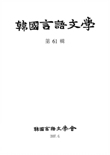- 영문명
- Review-An Interpretation of an Egg in the Song Seodongyo(薯童謠)
- 발행기관
- 한국언어문학회
- 저자명
- 황인덕(Hwang Indouk)
- 간행물 정보
- 『한국언어문학』韓國言語文學 第61輯, 187~209쪽, 전체 23쪽
- 주제분류
- 어문학 > 한국어와문학
- 파일형태
- 발행일자
- 2007.06.30

국문 초록
영문 초록
The word ‘Myo (卯)’, the same as an ‘Egg (卵)’, is known to be difficult to interpret in the old Korean song called 〈Seodongyo〉. This study will decipher it as an egg (卵) and then try to interpret its meaning more clearly.
For this, it is necessary to pay attention to the Korean folk cultural meaning of an egg. It is also necessary to compare its meaning in Korea with its meaning in other countries. While taking a good look at the folk materials in the neighboring countries, the author found that the content of 〈Seodongyo〉 was similar to the ethnic customs of an egg among some minority races in the southwest of China. It included the exchange of eggs, sharing eggs, and breaking eggs in relation to dating and marriage rituals among these minority races.
There are some similarities between 〈Seodongyo〉 and their folk culture. The expression of 〈Seodongyo〉 resembles the cultures of ‘breaking eggs’ and ‘exchange of eggs’ regarding the relationship between a man and a woman. It also means the promise of friendship and marriage between the two lovers.
Against this backdrop, it is estimated that some minority races in the southwest of China and Baekje(百濟) had cultural solidarity and a mutually influential relationship. Maybe, our culture in the Baekje era or Mahan(馬韓) era was influenced by the neighboring Chinese. Or, the township system (擔魯制) of Baekje had an influence upon the southwest of China and delivered our folk culture.
Considering this view, 〈Seodongyo〉 indicates that it does not intend to disclose an indecent rumor, but intends to express natural romantic love and a poetic feeling between the lovers.
For this, it is necessary to pay attention to the Korean folk cultural meaning of an egg. It is also necessary to compare its meaning in Korea with its meaning in other countries. While taking a good look at the folk materials in the neighboring countries, the author found that the content of 〈Seodongyo〉 was similar to the ethnic customs of an egg among some minority races in the southwest of China. It included the exchange of eggs, sharing eggs, and breaking eggs in relation to dating and marriage rituals among these minority races.
There are some similarities between 〈Seodongyo〉 and their folk culture. The expression of 〈Seodongyo〉 resembles the cultures of ‘breaking eggs’ and ‘exchange of eggs’ regarding the relationship between a man and a woman. It also means the promise of friendship and marriage between the two lovers.
Against this backdrop, it is estimated that some minority races in the southwest of China and Baekje(百濟) had cultural solidarity and a mutually influential relationship. Maybe, our culture in the Baekje era or Mahan(馬韓) era was influenced by the neighboring Chinese. Or, the township system (擔魯制) of Baekje had an influence upon the southwest of China and delivered our folk culture.
Considering this view, 〈Seodongyo〉 indicates that it does not intend to disclose an indecent rumor, but intends to express natural romantic love and a poetic feeling between the lovers.
목차
1. 머리말
2. ‘알’ 해석의 종전 관점과 한계점
3. ‘알’ 이해의 관련사례 소개
4. 상호 유사성의 실체적 기반 탐색
5. ‘알’ 민속문화에 견줘본 〈서동요〉의 내용 음미
〈참고문헌〉
[Abstract]
2. ‘알’ 해석의 종전 관점과 한계점
3. ‘알’ 이해의 관련사례 소개
4. 상호 유사성의 실체적 기반 탐색
5. ‘알’ 민속문화에 견줘본 〈서동요〉의 내용 음미
〈참고문헌〉
[Abstract]
키워드
해당간행물 수록 논문
참고문헌
최근 이용한 논문
교보eBook 첫 방문을 환영 합니다!

신규가입 혜택 지급이 완료 되었습니다.
바로 사용 가능한 교보e캐시 1,000원 (유효기간 7일)
지금 바로 교보eBook의 다양한 콘텐츠를 이용해 보세요!



